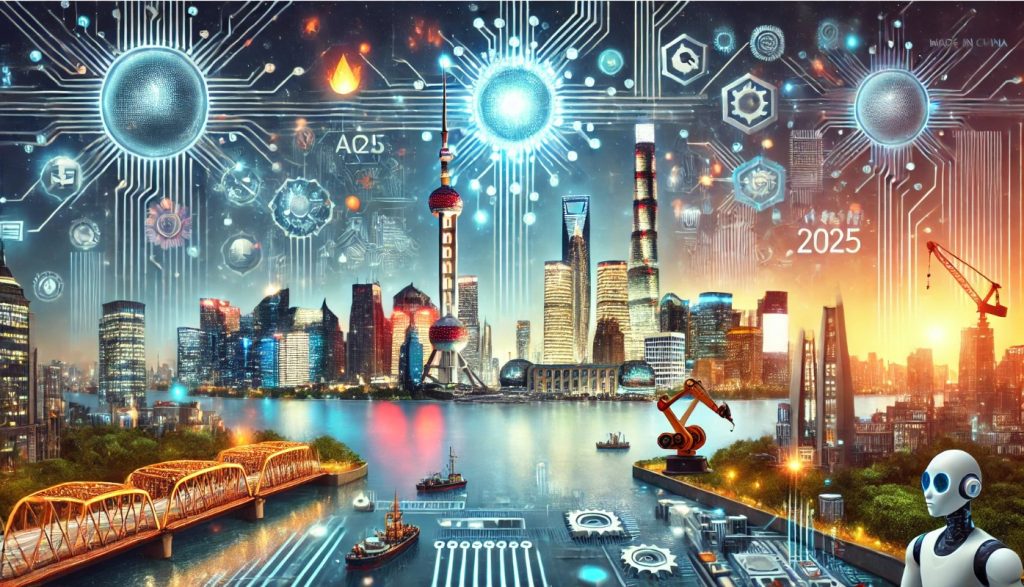The Made in China 2025 initiative represents an ambitious strategic plan by the Chinese government to elevate the country’s manufacturing sector to global leadership in high-tech industries. Launched in 2015 by the Chinese State Council, this initiative is designed to transform China’s industrial base from a manufacturing hub of low-cost, labor-intensive products to a powerhouse for cutting-edge, innovation-driven production. It is both a response to challenges in China’s current industrial capabilities and a proactive measure to secure its future as a global leader in technology and innovation.
The Made in China 2025 (MIC 2025) plan reflects China’s recognition that, to maintain long-term economic growth and global influence, it must overcome its dependence on foreign technology, especially in key sectors like semiconductors, robotics, aerospace, artificial intelligence, and biotechnology. By fostering self-sufficiency in these industries, China aims to avoid technological stagnation and reduce vulnerabilities associated with international trade tensions and geopolitical risks.
The Origins of Made in China 2025
The Context: China’s Economic Evolution
The Made in China 2025 initiative emerged at a pivotal moment in China’s economic evolution. Since the country’s reform and opening-up policies began in the late 1970s, China has been rapidly industrializing and transforming from a largely agrarian society into the world’s second-largest economy. However, China’s remarkable economic growth has largely been driven by labor-intensive industries, and it has often relied on foreign technology, knowledge, and expertise to fuel its industrial expansion.
As China’s economy matured, it became increasingly evident that its traditional development model was unsustainable. The country faced significant challenges, including an aging population, rising labor costs, and a growing environmental crisis. At the same time, it was becoming more dependent on foreign imports of high-tech products, especially in industries like semiconductors, aerospace, and information technology. China recognized that, to secure long-term prosperity and technological sovereignty, it had to pivot toward innovation-driven development and reduce reliance on foreign suppliers for strategic technologies.
Announcement of the Made in China 2025 Plan
In 2015, President Xi Jinping officially introduced the Made in China 2025 initiative, which would lay the framework for China’s future industrial development. The plan outlines a comprehensive roadmap to upgrade China’s manufacturing sector by emphasizing innovation, quality, and efficiency over quantity. The government’s goal is to transform China from a manufacturing hub focused on assembly and low-tech production to a leader in cutting-edge industries like robotics, artificial intelligence (AI), biotechnology, and clean energy technologies.
The Made in China 2025 strategy is built on several key pillars, each focusing on developing China’s capabilities in critical technology sectors and ensuring its global competitiveness in the 21st century. The plan aligns with other national strategies such as the “China Standards 2035” and “Internet Plus” initiatives, which aim to promote digital transformation and technological integration across industries.
Key Goals and Pillars of Made in China 2025
Promoting High-Tech Manufacturing and Innovation
One of the central objectives of the Made in China 2025 plan is to foster the development of high-tech industries and reduce the country’s dependence on foreign technology. The strategy focuses on increasing domestic production and innovation in several key sectors, including:
- Information Technology (IT) and Telecommunications: With the global shift toward the digital economy, China aims to develop world-class IT and telecommunications technologies. Key initiatives include the development of advanced semiconductor fabrication, 5G infrastructure, and the implementation of new artificial intelligence technologies.
- Aerospace and Aviation: China seeks to become a global leader in aerospace and aviation manufacturing by developing both civilian and military aerospace technologies. This includes the advancement of the C919 passenger jet, the Long March rocket series, and space exploration capabilities.
- High-End Equipment Manufacturing: This includes robotics, CNC machine tools, advanced materials, and precision manufacturing equipment. China is investing heavily in automation and smart manufacturing technologies to increase efficiency, precision, and output.
- Green Technology: As the world increasingly turns toward sustainable development, China is focused on green technologies, including electric vehicles (EVs), solar panels, wind turbines, and energy-efficient industrial processes. These sectors are integral to China’s broader goal of reducing its environmental footprint and moving toward a low-carbon economy.
Reducing Dependency on Foreign Imports
Another key goal of Made in China 2025 is to reduce the country’s reliance on foreign imports, particularly in high-tech industries where China lags behind global leaders like the United States, Japan, and South Korea. By 2025, China plans to significantly increase its self-sufficiency in critical technologies, such as semiconductors, advanced machinery, and software development.
The push for reducing reliance on foreign suppliers has been driven by China’s experiences with international trade tensions, particularly with the United States. The ongoing US-China trade war, for instance, has highlighted the vulnerabilities associated with China’s reliance on foreign high-tech components and software. With the Made in China 2025 initiative, the government aims to build a robust domestic supply chain capable of meeting the needs of the country’s rapidly expanding high-tech industries.
Improving the Quality of Manufacturing
While quantity has traditionally been a major focus of China’s manufacturing sector, the Made in China 2025 plan emphasizes the need to improve quality and efficiency in production. This goal involves upgrading China’s existing manufacturing base by incorporating smart manufacturing technologies, automation, and artificial intelligence into production processes.
China’s goal is to make its manufacturing sector more flexible and responsive to global market demands. The integration of Industry 4.0 technologies—such as the Internet of Things (IoT), cloud computing, big data, and robotics—into industrial processes will enable Chinese manufacturers to reduce costs, improve product quality, and speed up production cycles.
Innovation in Key Strategic Sectors
The Made in China 2025 initiative identifies ten strategic industries that are crucial to China’s long-term economic future. These sectors will receive significant investment and policy support to promote innovation, drive technological development, and strengthen China’s global competitiveness. The ten key industries are:
- Next-generation Information Technology
- High-end Numerical Control Machinery and Robotics
- Aerospace and Aviation
- Maritime Engineering Equipment and High-tech Ships
- Advanced Railway Transportation Equipment
- Energy-saving and New Energy Vehicles
- High-tech Materials
- Biotechnology and Pharmaceuticals
- Advanced Medical Devices and Equipment
- Agriculture Machinery
Each of these sectors is viewed as essential to the future growth of China’s economy and the enhancement of its global industrial leadership. In particular, the focus on robotics and artificial intelligence is aimed at creating a new wave of automation that can boost productivity and provide solutions to labor shortages in the coming decades.
Strategies to Achieve Made in China 2025 Goals
Government Support and Policy Interventions
The success of Made in China 2025 is heavily reliant on strong government support. The Chinese government has committed to providing both financial and policy backing for industries and companies involved in the initiative. This includes:
- Subsidies and tax incentives for high-tech industries.
- Research and development (R&D) funding to foster innovation in key sectors.
- Targeted investments in state-owned enterprises and private companies to build technological capacity.
- Intellectual property (IP) protection to safeguard domestic innovations and technologies.
- Public-private partnerships to facilitate collaboration between government agencies and private enterprises.
In addition, the government has been actively involved in shaping industrial policies that support the development of critical technologies. For example, China’s National Innovation-Driven Development Strategy is designed to align R&D efforts with the goals of the Made in China 2025 plan.
Domestic Innovation and Talent Development
At the heart of the Made in China 2025 plan is the drive to innovate domestically. By encouraging Chinese companies to increase R&D investment and move up the value chain, the government hopes to transition from being a mere assembler of foreign technologies to a leader in global innovation.
A key part of this strategy is the development of high-quality talent in science, technology, engineering, and mathematics (STEM) fields. To foster a culture of innovation, China has invested in building top-tier universities, research institutions, and technology parks that foster innovation. Moreover, the government has put in place policies to attract overseas Chinese scientists and engineers to return to China and contribute to the country’s development.
Leveraging Strategic Partnerships and Global Integration
While self-sufficiency is a primary goal of Made in China 2025, the initiative recognizes that global collaboration is necessary for success. China has actively sought to establish strategic partnerships with other countries and multinational companies to foster knowledge exchange, technological transfer, and joint ventures.
For instance, China has been involved in partnerships with countries and companies in Europe, Asia, and Africa to advance in sectors like renewable energy, electric vehicles, and space exploration. By leveraging its growing domestic market and technological capabilities, China hopes to increase its influence over global technological standards and innovation.
The Chinese government has also pursued strategic investments in foreign technology companies to acquire advanced knowledge in critical areas such as semiconductors, artificial intelligence, and biotechnology. By doing so, China seeks to bridge the technology gap and accelerate its own technological development.
Challenges and Criticisms of Made in China 2025
Technological Barriers and Global Competition
Despite its ambitious goals, Made in China 2025 faces several significant challenges. One of the most pressing obstacles is China’s reliance on foreign technology, especially in areas like semiconductors, operating systems, and software. While China has made significant progress in developing its own capabilities in these fields, it still faces technological gaps that hinder its ability to compete with industry leaders such as the United States, Japan, and the European Union.
For example, China’s efforts to develop its own semiconductor industry have been thwarted by technological barriers and the complex nature of the semiconductor supply chain. Despite massive investments in semiconductor research, China remains dependent on foreign suppliers for high-end chips, especially in areas like memory and logic processors.
Trade Tensions and Geopolitical Risks
Another significant challenge to Made in China 2025 is the potential for trade tensions and geopolitical risks. In recent years, China has been embroiled in ongoing trade disputes, particularly with the United States. These tensions have created an uncertain environment for Chinese companies, particularly those reliant on foreign technologies or international supply chains. Restrictions on Chinese companies like Huawei, for example, have limited China’s access to advanced technologies like 5G equipment and semiconductors.
Geopolitical risks also affect China’s ambitions to expand its industrial and technological base, particularly in industries like telecommunications and artificial intelligence. Countries and companies wary of China’s rise as a global technology leader have raised concerns about data security, privacy issues, and intellectual property theft. These tensions could impact China’s ability to achieve its goals in Made in China 2025.
Environmental and Social Challenges
The transformation envisioned by Made in China 2025 comes with its own set of environmental and social challenges. As China ramps up its focus on high-tech industries and green technologies, it will also need to address the environmental impact of its manufacturing processes. At the same time, social issues such as labor displacement due to automation and technological advancement will need to be managed. This is especially important in light of China’s aging population and the accompanying challenge of maintaining a competitive workforce.
The Road Ahead for Made in China 2025
While the Made in China 2025 plan has been met with significant challenges and criticism, it remains a central aspect of China’s industrial and economic strategy. With ambitious goals and massive investments in technology, China is positioning itself to become a global leader in key industries. Whether it can overcome its technological gaps, geopolitical tensions, and domestic challenges will determine the success of this initiative.
The road ahead will require China to balance innovation with international cooperation, ensure sustainable development practices, and continue to invest heavily in both human capital and technological infrastructure. If successful, Made in China 2025 could reshape global industries and establish China as the world’s preeminent technological powerhouse in the decades to come.







